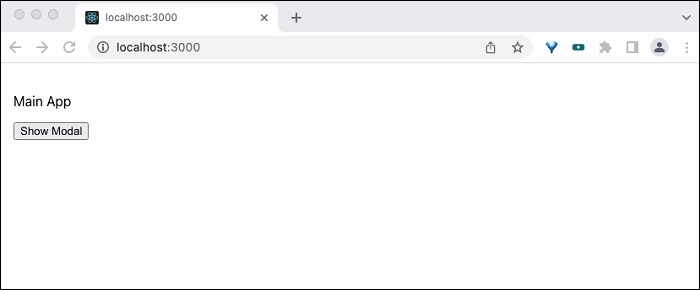Portals 为组件提供了一种方法,可以将其子节点呈现到其自己的 DOM 层次结构之外的 DOM 节点中。Portal 可以在模型对话框、弹窗、工具提示等中使用,其中父节点(渲染组件)和子 DOM 节点(模型对话框)优先在不同的 DOM 节点中渲染。
在本章中,让我们了解门户是如何工作的,以及如何在我们的应用程序中应用它。
门户的概念和用法
让我们考虑一下,在主文档中有两个DOM节点,如下所示:
在这里,根 DOM 节点将与主 react 组件相连。每当 react 应用程序需要通过将模态对话框附加到 modelRoot DOM 节点而不是在其自己的 DOM 元素内渲染模型对话框来显示模态对话框时,它就会使用 modalRoot。
这将有助于将模态对话框与实际应用程序分开。将模态对话框与其父 DOM 元素分离将使其不受其父 DOM 元素的样式影响。样式可以单独应用,因为模式对话框、工具提示等在样式方面与其父项不同。
React 在 ReactDOM 包中提供了一个特殊的方法 createPortal 来创建门户。该方法的签名如下 -
这里
- child 是由父组件呈现的模型对话框、工具提示等。
container 是父 DOM 节点(上面示例中的 domNode)之外的 DOM 元素
应用门户
让我们创建一个新的 react 应用程序,以学习如何在本节中应用门户。
首先,创建一个新的 react 应用程序并使用以下命令启动它。
cd myapp
npm start
接下来,打开 App.css (src/App.css) 并删除所有 CSS 类,并为模态对话框添加 CSS。
接下来,打开 index.html (public/index.html) 并添加一个 DOM 节点以支持门户
接下来,创建一个简单的组件 SimplePortal (src/Components/SimplePortal.js) 并渲染一个模态对话框,如下所示 -
这里
- createPortal 创建一个新的门户并呈现一个模态对话框。
- 模态对话框的内容是通过 this.props.children 从组件的子项中检索的
- 关闭按钮操作通过 props 处理,并由父组件处理。
接下来,打开 App 组件(src/App.js),并使用 SimplePortal 组件,如下图 -
这里
- 导入的 SimplePortal 组件
- 添加了一个按钮来打开模式对话框
- 创建了一个处理程序来打开模式对话框
- 创建了一个处理程序来关闭模态对话框,并通过 onClose 属性将其传递给 SimplePortal 组件。
最后,在浏览器中打开应用程序并检查最终结果。

总结
React 门户提供了一种简单的方法来访问和处理组件外部的 DOM。它使事件能够在不同的 DOM 节点之间冒泡,而无需任何额外的努力。



